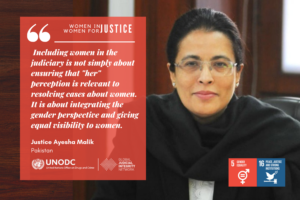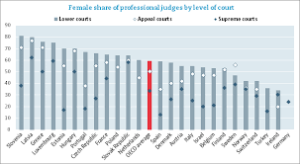
In the hallowed halls of justice, recent occurrences have thrust into the limelight an enduring predicament that afflicts judiciaries across the globe: the glaring underrepresentation of women in judicial roles. The demise of two trailblazing jurists, Justice Fathima Beevi in India on November 23rd and Sandra Day O’Connor in the United States on December 1st, has rekindled conversations surrounding the worldwide judicial gender gap and the formidable obstacles women encounter in securing their seat at the apex of the legal realm.
Justice Fathima Beevi: Pioneering a Legacy
Within the intricate tapestry of Indian jurisprudence, Justice Fathima Beevi emerged as a pioneer, shattering the crystalline barriers of gender bias. Her elevation as the inaugural female Supreme Court justice in the 1980s stood as a watershed moment, a symbolic stride toward an all-encompassing judiciary. However, her recent demise at the venerable age of 96 begets contemplation on the measured pace of transformation and the obstinate gender imbalances persisting within India’s judicial corridors.
Shifting our focus to a broader panorama, the global panorama of women in judicial roles paints a disheartening tableau. Despite headway in various domains, the representation of women in the upper echelons of the judiciary remains disproportionately scant. This gender lacuna transcends geographical confines, beckoning meticulous scrutiny of the entrenched barriers impeding women’s ascension to judicial eminence.
Sandra Day O’Connor: Shattering Frontiers in the US Judiciary
On the shores of the United States, Sandra Day O’Connor’s investiture as the inaugural female Supreme Court justice in 1981 etched an indelible mark in history. O’Connor’s tenure on the bench, characterized by sagacity and pragmatism, positioned her as a trailblazer within the American legal framework. Nevertheless, her demise at the venerable age of 93 prompts introspection on the broader canvas of gender disparities within the US judiciary.
A Comparative Lens: US versus India

For a nuanced comprehension of the gender gap in judiciaries, a comparative analysis of the situations in the United States and India proves imperative. While both nations have witnessed the emergence of groundbreaking women jurists, the cadence of transformation and the extent of representation diverge markedly. The United States has made discernible strides, yet hurdles persist, exemplified by the belated appointment of its inaugural Black Woman Judge just last year. This laudable milestone, however, underscores the sustained tribulations faced by women of color in attaining apical judicial roles.
Global Judicial Gender Discrepancy: Numeric Realities
Transitioning to a global vista, a dissection of the numerical landscape unveils an unvarnished truth. The global judicial gender gap endures, with women occupying disproportionately fewer upper echelons of legal authority. Redressing this chasm mandates confronting deeply ingrained societal norms, systemic predispositions, and the imperative for structural overhauls within legal frameworks worldwide.
The Interconnectedness of Diversity: Inaugurating the First Black Woman Judge in the US
Within the sphere of judicial diversity, the recent investiture of the first Black Woman Judge in the United States assumes monumental significance. This groundbreaking occurrence spotlights the interconnected struggle for representation within the legal fraternity. While a commendable stride forward, it underscores the exigency for more holistic endeavors to guarantee the adequate representation of women from all walks of life on the judicial dais.
Obstacles and Prospects

Navigating the labyrinth of impediments confronting women in the legal arena, this discourse shall scrutinize the multifaceted nature of these hindrances. From societal expectations to institutional biases, women grapple with barriers impeding their progression within the judiciary. Prospects for change lie in proactive initiatives fostering gender parity, mentorship programs, and policies tailored to address the distinctive challenges confronting women in the legal domain.
The Legal Gender Disparity: Unveiling Systemic Injustices
The legal gender gap bequeaths a manifold challenge extending beyond the dearth of women judges. Across legal landscapes worldwide, women contend with systemic injustices concerning opportunities, remuneration, and career advancement. Bridging this legal gender gap necessitates sweeping reforms, encompassing proactive measures to dismantle unconscious biases and cultivate a more inclusive legal milieu.
Breaking Barriers: Forging Ahead
As we reflect upon the legacy of Justice Fathima Beevi and navigate the convolutions of judicial diversity, the imperative to dismantle entrenched biases, advocate for policy metamorphoses, and nurture a culture that acknowledges and celebrates the contributions of women in the legal arena becomes evident. Breaking barriers is an ongoing odyssey, requiring sustained efforts to usher in a legal landscape that genuinely mirrors the diverse societies it serves.
Conclusion: A Global Clarion Call to Action

The demises of Justice Fathima Beevi and Sandra Day O’Connor have prompted a global introspection on the sluggish trajectory toward gender equality in the judiciary. As we scrutinize the statistics and juxtapose the situations in the United States and India, it becomes apparent that coordinated endeavors are imperative to dismantle the systemic hurdles impeding the appointment of women judges. The recent historic investiture of the first Black Woman Judge in the United States serves as a positive impetus, yet it must catalyze broader initiatives to ensure a judiciary that authentically mirrors the multifarious societies it serves. Only through such endeavors can we aspire to surmount the persistent gender disparities in the legal realm on a global scale.










